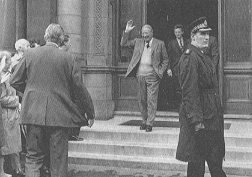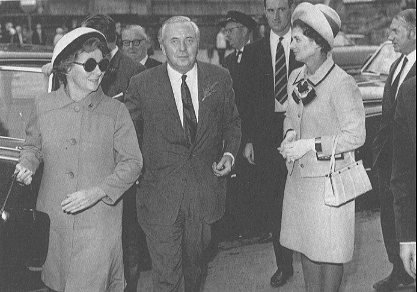A Double Life
But the hotel has always led a double life. When
it looked down it saw the railway. When it looked up it surveyed the city.
Cosmopolitan and very much part of home, for the
greater part of the 20th century the North British Hotel has been firmly fixed as a city
institution. Over the years a regular galaxy of film and sports stars, princesses and
politicians, have posed for photographs by the hotel pillars on Princess Street.
Elizabeth Taylor in cloche hat and dark glasses
walked among American visitors in the North British reception hall and no-one spotted she
was there. The lobby of a luxury hotel is a fascinatingly bustling place where stars may
shine or remain unseen if they prefer. Miss Taylor was quite likely to be outnumbered by
guests of thoroughly down to earth organisations from the Scottish Rugby Union, the
Chiropodists, High Constables or the Edinburgh Chamber of Commerce. More sensitive
international celebrities were ushered discreetly in through the Waverley Steps entrance,
but even as they did so local people by the hundred would swing in through the revolving
door at the front for balls, banquets and business breakfasts. Jack Maquire says,
"Anyone who was anyone living in Edinburgh or visiting the city came to the North
British".

Prime Minister Edward Heath

Prime Minister Harold Wilson arrives at the Hotel with Mary
The hotel has always been ready to do that bit
extra for its guests. In the 1960's an Eastern potentate took over the elegant second
floor and had it rearranged so that he could sleep on cushions on the floor with armed
guards along the corridors. A mysterious visitor during the Second World War, however, got
less favoured treatment. He aroused the suspicions of the head cashier and was arrested as
a German spy.
There seems no truth in the legend that a secret
passage once connected hotel with Holyrood Palace, the Royal Family's home in Edinburgh
("that would be one hell of a passage" observes Maquire). But for many years
until Holyrood accommodation was extended the NB entertained the annual overflow of Royal
visitors to the Palace. Jackie Monteith, sauce chef until 1987, remembers the Queen
Mother's liking for plain roast lamb for lunch, while the old Princess Royal had her own
special dessert: fingers of Madeira cake dipped in egg white rolled in sugar and toasted
under the grill.
By the time the hotel closed for refurbishment
in 1988 it had become so much part of city life that an interesting group of people met to
mark the occasion with a grand breakfast, promising to celebrate the reopening in the same
way. Interesting because in 1902 members of that same vigilant conservation group, the
Cockburn Association, were horrified at the way the new hotel completely dominated its
surroundings. "Any appreciation of its architecture is neutralised by the sense of
disproportion which its height and breadth conveys", was the society's comment at the
time. Other critics commented on its aggressive bulk, the bulbous clock tower,
"standing at the hinge of Old and New Towns it is coarse and obstructive at
once".
 Next
Page Next
Page
|

